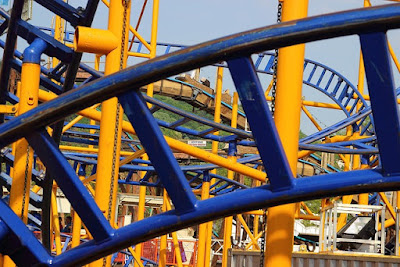
05 Jul Amusement Park Physics Lessons
We’re going to Story Land today! It’s a fairy tale themed amusement park for little kids. It’s perfect for my daughters and their cousins who are coming with us. Going to Story Land is a good reason to share some science lessons that can be taught through the context of amusement park rides like roller coasters and spinning tea cups.
- CK-12 has a lot of interactive simulations for physics and math concepts. One of those is this roller coaster simulator. The voiceover for the simulation is very robotic. The redeeming quality of CK-12’s roller coaster simulation is that students can customize the size of the roller coaster to see how the changes they make impact the speed, the potential energy, the kinetic energy, and the heat generated by the roller coaster.
- PhET offers lots of lessons and interactives to help students understand various forces in physics. Make sure you look at their list whenever you need help explaining a physics concept to students.
- PBS Learning Media offers a handful of resources for teaching and learning about the physics of roller coasters. Energy Transfer in a Roller Coaster is an interactive lesson designed for elementary and middle school students. Energy in a Roller Coaster is a simple interactive graphic that students can use to see how changes in a roller coaster design impact the speed of the roller coaster. Centripetal Force in Roller Coaster Loops is a short video that demonstrates why its not just the harness keeping your seat in a roller coaster.
- Teach Engineering offers a hands-on lesson plan for teaching about the physics of roller coasters. In the lesson students build and test model roller coasters to learn about the forces that affect the speed of roller coasters.
- How Roller Coasters Affect Your Body is a TED-Ed lesson that begins with the story of the first roller coaster in America and the injuries it caused to riders. The lesson then moves on to explain how the forces of a roller coaster can affect your body, how roller coaster designers account for those forces, and why roller coasters have gotten faster and safer over the years.
-
CK-12 offers a couple of interactive simulations and lessons about centripetal force. Students can use these on their own or as part of a larger lesson that you lead.
-
Here’s a student-produced video addressing centripetal force in the context of “the tea cup problem.” Jump to the two minute mark to see how he enlists the help of his brother to create the explanation.
-
Planet Nutshell published a concise, animated explanation of centripetal force. You can watch it here or as embedded below.
New course starting July1st! 25 Search Strategies You Need to Know!
We’re going to Story Land today! It’s a fairy tale themed amusement park for little kids. It’s perfect for my daughters and their cousins who are coming with us. Going to Story Land is a good reason to share some science lessons that can be taught through the context of amusement park rides like roller coasters and spinning tea cups. CK-12 has a lot of interactive simulations for physics and math concepts. One of those is this roller coaster simulator. The voiceover for the simulation is very robotic. The redeeming quality of CK-12’s roller coaster simulation is that students can customize the size of the roller coaster to see how the changes they make impact the speed, the potential energy, the kinetic energy, and the heat generated by the roller coaster. PhET offers lots of lessons and interactives to help students understand various forces in physics. Make sure you look at their list whenever you need help explaining a physics concept to students. PBS Learning Media offers a handful of resources for teaching and learning about the physics of roller coasters. Energy Transfer in a Roller Coaster is an interactive lesson designed for elementary and middle school students. Energy in a Roller Coaster is a simple interactive graphic that students can use to see how changes in a roller coaster design impact the speed of the roller coaster. Centripetal Force in Roller Coaster Loops is a short video that demonstrates why its not just the harness keeping your seat in a roller coaster. Teach Engineering offers a hands-on lesson plan for teaching about the physics of roller coasters. In the lesson students build and test model roller coasters to learn about the forces that affect the speed of roller coasters. How Roller Coasters Affect Your Body is a TED-Ed lesson that begins with the story of the first roller coaster in America and the injuries it caused to riders. The lesson then moves on to explain how the forces of a roller coaster can affect your body, how roller coaster designers account for those forces, and why roller coasters have gotten faster and safer over the years. CK-12 offers a couple of interactive simulations and lessons about centripetal force. Students can use these on their own or as part of a larger lesson that you lead. Here’s a student-produced video addressing centripetal force in the context of “the tea cup problem.” Jump to the two minute mark to see how he enlists the help of his brother to create the explanation.Planet Nutshell published a concise, animated explanation of centripetal force. You can watch it here or as embedded below.
New course starting July1st! 25 Search Strategies You Need to Know! Amusement Parks, Educational Videos, Free Technology For Teachers, PhET, Physics, ScienceRead More
Amusement Parks, Educational Videos, Free Technology For Teachers, PhET, Physics, ScienceRead More


Sorry, the comment form is closed at this time.